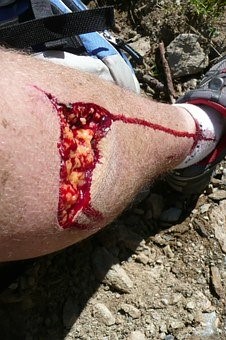 A wound is considered non-healing if it is not cured within three months or it remains in the inflammatory stage for long. However, some factors determine the healing such as the condition of the wound or the health of an individual. If a wound does not heal fast a specialist should look at it because sometimes it is a reflection of an underlying disease. An external wound is painful with visible redness around the skin due to the disintegration of the tissue; there could be loss of the epidermis, dermis and sometimes subcutaneous fat. Types of wounds include cuts, scrapes, lacerations, abrasions, gashes, scratches, tears, floor burns, and bruises.
A wound is considered non-healing if it is not cured within three months or it remains in the inflammatory stage for long. However, some factors determine the healing such as the condition of the wound or the health of an individual. If a wound does not heal fast a specialist should look at it because sometimes it is a reflection of an underlying disease. An external wound is painful with visible redness around the skin due to the disintegration of the tissue; there could be loss of the epidermis, dermis and sometimes subcutaneous fat. Types of wounds include cuts, scrapes, lacerations, abrasions, gashes, scratches, tears, floor burns, and bruises.
Stages of wound healing
Stage I: Inflammatory stage, which is the first stage of the wound formation and it, attempts to restore normal state by forming blood vessels to control bleeding. At this stage, the wound appears red, swollen and is warm.
Stage II: The proliferative stage lasts about 3 weeks or longer depending on the severity of the wound. This is granulation where special cells known as fibroblasts make collagen fill the wound. New blood vessels start to form and a layer of skin gradually covers the wound.
Stage III: Remodeling and maturation stage can last up to two years. New collagen changes the skin around the wound forming a scar that is almost as strong as the original tissue.
Causes of nonhealing wounds
- Infections by bacteria colonization which slows down the healing process of the wound.
- Excess use of antibiotics has been cited as a problem leading to non-healing wounds.
- Microbiology such as arterial insufficiency, pressure and venous insufficiency that reduces the capacity of the skin to repair itself causing a non-healing wound.
Wound care treatment
Wound treatment is effective because it promotes wound healing and reduces the risk of infection. If you are looking for some expert advice on wound care, you may want to seek help from a podiatrist. Feel free to contact our office to make an appointment with our podiatrist. Our foot and ankle specialist, Dr. Ejodamen Shobowale can provide you with the care you need to keep you pain-free and on your feet
- Debridement
Debridement is the process of removing damaged or dead tissue and foreign objects from the wound.
Types of wound debridement
Biological debridement uses sterile maggots that digest the dead tissue and pathogens of the wound, giving space to the formation of new cells.
Enzymatic debridement uses a topical agent to chemically liquefy necrotic tissues with enzymes, which devitalize the tissues within the wound. This method can be used together with surgical debridement.
Autolytic debridement is long-term and works by maintaining moisture beneath a wound’s dressing using the body’s enzymes. Dressing absorbency is important in the maintenance of moisture.
Mechanical debridement by hydrotherapy technique and wet-to-dry dressing is cost-effective though it can cause damage to healthy tissues. The wet-to-dry dressing is changed every 4 to 6 hours.
Conservative sharp and surgical debridement is performed by a skilled practitioner who removes the biofilm and devitalized tissue. The level of debridement is determined by the level of tissue removal.
- Nutritional supplements
Vitamin C and Aloe Vera through research have been found to play an active role in wound healing. Most diets are deficient in nutrients that enhance healing in the body. Vitamin C stimulates the immune system by increasing amino acid arginine, which activates metabolic functions to stimulate the cells to protect against bacteria. Aloe Vera can be applied or taken for internal wounds, it provides micronutrients that reduce pain and inflammation, and prevent infections. Turmeric has antioxidant properties that decrease inflammation and encourage healing by transforming the growth factor. Pineapples have a proteolytic enzyme that dissolves proteins and works best for wounds with too much scar tissue.
Seek wound care specialist services if the wound is split open and may need stitches when pain is severe and does not get better after taking painkillers and in case the wound is deep or it covers a large area. Seek immediate attention if the area around the wound looks infected. If you have any questions, please feel free to contact our office located in Cypress, TX. Our Cypress office can handle all of your wound care issues. We will provide you with the latest diagnostic and treatment methods for all wound-related issues.